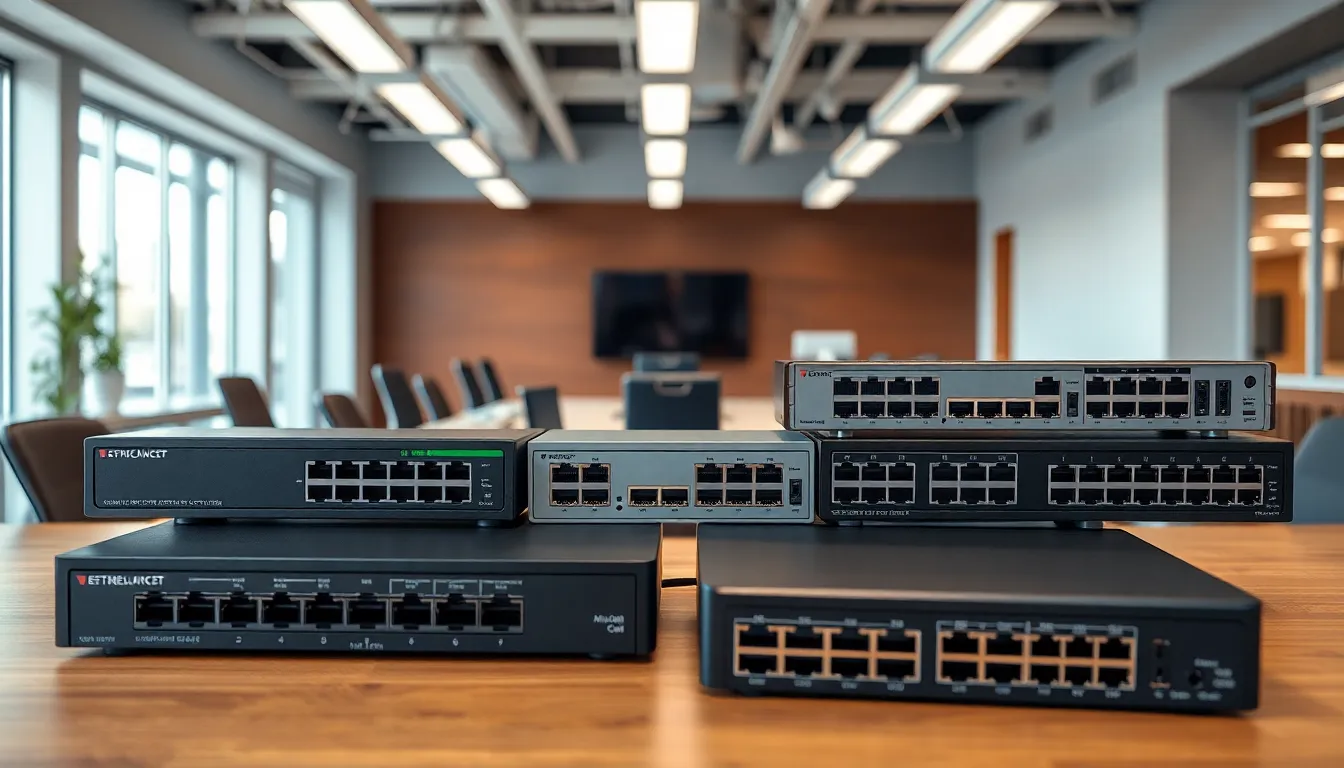In today’s fast-paced digital world, seamless connectivity is essential for both home and business networks. An Ethernet switch plays a crucial role in this connectivity by efficiently directing data traffic between devices. By connecting multiple devices within the same local area network (LAN), it ensures that information flows smoothly, reducing latency and enhancing overall performance.
As more devices come online, understanding the functionality and benefits of an Ethernet switch becomes increasingly important. From improving network efficiency to supporting high-speed data transfer, these devices are fundamental in creating reliable and robust networks. Whether it’s for a small office or a large enterprise, knowing how to choose the right Ethernet switch can significantly impact network performance and user experience.
Table of Contents
ToggleOverview of Ethernet Switches
Ethernet switches play a vital role in local area networks by connecting multiple devices. They act as central nodes, managing the data traffic efficiently. A switch examines incoming data packets and determines the appropriate destination for each packet. This process ensures that data reaches its intended device without unnecessary delays.
Ethernet switches come in various types, including unmanaged, managed, and smart switches.
- Unmanaged Switches: These plug-and-play devices offer basic connectivity and require no configuration. They’re ideal for small networks.
- Managed Switches: These provide advanced features such as traffic management, security options, and network monitoring capabilities. They’re suitable for larger networks needing precise control.
- Smart Switches: These offer a balance between unmanaged and managed switches, combining easy configuration with some management features for enhanced performance.
Switches also support different speeds, typically 10/100/1000 Mbps, helping to accommodate different networking needs. The choice of switch impacts both network efficiency and data transfer speeds.
In terms of port configurations, Ethernet switches can support various numbers of ports, ranging from 5 to 48, thus allowing scalability as network needs grow. Choosing the right switch involves considering factors like network size, speed requirements, and budget. Advanced switches might also offer features like Power over Ethernet (PoE), facilitating the delivery of power and data through a single cable.
Organizations benefit from deploying Ethernet switches, as they enhance the performance of devices connected within a network. By investing in the right type of switch, both home users and enterprises can improve data transfer rates, scalability, and overall network reliability.
Key Features of Ethernet Switches

Ethernet switches come equipped with several key features that enhance network performance and usability. Understanding these features helps users choose the right switch for their needs.
Port Configuration
Port configurations vary widely among Ethernet switches, impacting scalability and flexibility. Common configurations range from 5 to 48 ports, enabling devices to connect within a local area network (LAN).
- 5 to 10 Ports: Suitable for small networks, like home offices or startups, where fewer devices connect simultaneously.
- 16 to 24 Ports: Ideal for medium-sized businesses, accommodating a moderate number of devices and ensuring future expansion.
- 24 to 48 Ports: Designed for large enterprises needing extensive connectivity for numerous devices, like computers, printers, and servers.
Multiple ports mean greater device connectivity, enhancing productivity and collaboration in network environments.
Speed and Bandwidth
Ethernet switches support various speeds and bandwidth options that determine data transfer rates. Most commonly, they operate at:
| Speed Options | Description |
|---|---|
| 10 Mbps | Basic speeds for legacy devices, mainly used in older networks. |
| 100 Mbps | Standard for many small office networks, sufficient for basic internet use. |
| 1 Gbps (1000 Mbps) | Common in modern networks, offering high-speed connectivity for demanding applications. |
Bandwidth capacity influences how much data can travel through the network simultaneously. Higher bandwidth supports activities such as video conferencing, large file transfers, and data-heavy applications without major performance drops. When selecting an Ethernet switch, considering both port configuration and speed ensures efficient data handling for any given network setup.
Types of Ethernet Switches
Various types of Ethernet switches cater to different networking needs. Understanding these types helps users select the most suitable switch for their specific requirements.
Managed Switches
Managed switches provide advanced features for network control and monitoring. These switches allow users to configure, manage, and monitor the network effectively. Key features include VLAN support, traffic prioritization, and security protocols. Managed switches are ideal for larger networks where performance, security, and scalability are critical. They often include a web interface or command-line interface for easier management. Typically, prices range from $100 to $500, depending on port count and features.
Unmanaged Switches
Unmanaged switches are basic, plug-and-play devices that don’t require configuration. These switches offer simple connectivity, making them a straightforward choice for small networks or home offices. Unmanaged switches typically support limited features but provide essential data transfer capabilities. With prices usually under $100, these switches serve well in environments with low complexity and minimal traffic demands.
PoE Switches
Power over Ethernet (PoE) switches deliver both data and electrical power through a single Ethernet cable. This capability simplifies installations by eliminating the need for separate power supplies for connected devices, such as IP cameras and wireless access points. PoE switches come in managed and unmanaged varieties, offering flexibility based on network needs. Common specifications include 15.4W (PoE), 30W (PoE+), and 60W (PoE++), allowing users to power various devices. Prices typically vary from $150 to $600, depending on power capacity and features.
Benefits of Using Ethernet Switches
Ethernet switches significantly enhance network connectivity, offering numerous benefits for both home and business environments. Their efficient data traffic management is vital for improved performance and security across networks.
Improved Network Performance
Improved network performance is a key advantage of using Ethernet switches. Switches manage traffic by directing data packets only to the intended devices, minimizing network congestion. This targeted data transmission reduces latency compared to hubs, where data is broadcasted to all connected devices. Moreover, most switches support multiple transfer speeds, including 10/100/1000 Mbps, accommodating a variety of applications and ensuring optimal performance for tasks such as video conferencing or gaming. Additionally, switches with higher port counts (from 5 to 48 ports) allow for easy expansion as network requirements increase, further supporting scalable and efficient data handling.
Enhanced Security
Enhanced security features in Ethernet switches provide greater protection for networked devices. Managed switches offer advanced security protocols, including Virtual LANs (VLANs) and Access Control Lists (ACLs), to segment network traffic and restrict access to sensitive information. This level of control is essential for businesses handling confidential data. Furthermore, certain switches support features like port security and Dynamic Host Configuration Protocol (DHCP) snooping, which help defend against unauthorized access and network attacks. By implementing an Ethernet switch with these safeguards, organizations can effectively mitigate security risks and maintain a secure networking environment.
Ethernet switches play a pivotal role in modern networking by enhancing connectivity and performance. They streamline data traffic across various devices and adapt to the growing demands of both home and business environments. By understanding the differences between unmanaged, managed, and PoE switches, users can make informed choices that align with their specific needs.
Investing in the right Ethernet switch not only boosts data transfer speeds but also ensures scalability and security. As networks become more complex, the advantages of using Ethernet switches become increasingly clear. Embracing this technology can lead to a more efficient and reliable network experience, supporting everything from everyday tasks to high-demand applications.



